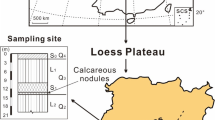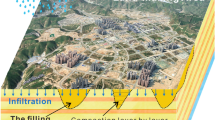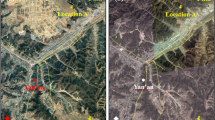Abstract
Loess is widely distributed in northern China on the Loess Plateau, which is well known for its serious soil erosion and shortage of urban land. Undertaking filling construction under the conditions of an optimum water content is very difficult for so many mega-engineering projects in loess regions because of the (1) moisture loss that occurs over a certain transport distance, (2) water shortage, and (3) construction costs. Consequently, the inadequate compaction behaviors of such compacted loess without improvement may have significant effects on the safety and reliability of man-made structures. This study focuses on the compaction mechanism of large-scale and high-fill compacted soil under complex construction conditions by comparing intact loess with in-situ compacted loess from a microstructural perspective. The morphological characteristics of the particles and pores of (1) intact soil obtained from a typical 75-m high loess–paleosol section, and (2) compacted soil obtained from a 30-m-deep filling section are described. The main experimental comparisons between the intact soil and compacted soil are discussed with respect to the pore size distribution (PSD), microstructural micrographs, and characteristics of the particle/pore structure. The results showed that both the intact soil and compacted soil exhibited trimodal characteristics in their PSDs; hence, a new pore classification is presented to agree with the pore name. The compaction mechanism of compacted loess was mainly attributed to two aspects: one is the progressive and ordered transformation of different pore sizes, and the other is the gradual rearrangement of order and close cementation of particles under dynamic loading. The results of the present study are very useful for better understanding the properties of loess soil and improving engineering construction safety in loess areas.















Similar content being viewed by others
References
Assallay AM, Rogers CDF, Smalley IJ (1997) Formation and collapse of metastable particle packings and open structures in loess deposits. Eng Geol 48(1–2):101–115
Delage P, Cui YJ, Antoine P (2005) Geotechnical problems related with loess deposits in Northern France. Proceedings of International Conference on Problematic Soils. Eastern Mediterranean University Press, Famagusta, North Cyprus 517−540
Diamond S (1970) Pore size distribution in clays. Clays Clay Miner 18:7–23
Fang XW, Shen CN, Wang L (2013) Research on microstructure of Q2 loess before and after wetting. Rock Soil Mech 34(5):1319–1324 (in Chinese)
Gao GR (1980) Microstructure of Chinese loess. Chin Sci Bull 20:945–948 (in Chinese)
Gao GR (1990) A structure theory for collapsing deformation of loess soils. Chin J Geotech 12(4):1–10 (in Chinese)
Gu ZY (1991) Carbonate isotopic composition of loess-Paleosol sequence and paleoclimatology variation. Chin Sci Bull 10:767–770 (in Chinese)
Jiang MJ, Zhang FG, Hu HJ (2014) Structural characterisation of natural loess and remoulded loess under triaxial tests. Eng Geol 181:249–260
Kemball C (1946) On the surface tension of mercury. Trans Faraday Soc 42:526–537
Lawrence GP (1978) Stability of soil pores during mercury intrusion porosimetry. J Soil Sci 29:299–304
Lei XY (1987) Pore type of loess in China and collapsibility. Sci Ch (series b) 17(12):1309–1318 (In Chinese)
Li TL, Fan JW, Xi Y, Xie X, Hou XK (2019) Analysis for effect of microstructure on SWCC of compacted loess. J Eng Geol 27(5):1019–1026 (in Chinese)
Li YR, He SD, Deng XH, Xu YX (2018) Characterisation of macropore structure of Malan loess in NW China based on 3D pipe models constructed by using computed tomography technology. J Asian Earth Sci 154:271–279
Lin Z, Liang W (1982) Engineering properties and zoning of loess and loess-like soils in China. Can Geotech J 19(1):76–91
Liu DS (1966) The material composition and structure of loess. Science press, Beijing (in Chinese)
Liu DS (1985) Loess and environment. Science press, Beijing (in Chinese)
Monroy R, Zdravkovic L, Ridley A (2010) Evolution of microstructure in compacted London Clay during wetting and loading. Geotechnique 60(2):105–119
Ng CWW, Sadeghi H, Hossen SB, Chiu CF, Alonso EE, Baghbanrezvan S (2016) Water retention and volumetric characteristics of intact and re-compacted loess. Can Geotech J 53:1258–1269
Rogers CDF, Dijkstra TA, Smalley IJ (1994) Hydroconsolidation and subsidence of loess: studies from China, Russia, North America and Europe. Eng Geol 37:83–113
Shao XX, Zhang HY, Tan Y (2018) Collapse behavior and microstructural alteration of remoulded loess under graded wetting tests. Eng Geol 233:11–22
Wang JD, Li P, Ma Y, Vanapalli SK, Wang XG (2019) Change in pore-size distribution of collapsible loess due to loading. Acta Geotech 5:815–823
Wang M (2010) Study on structure of collapsible loess in China. Doctoral dissertation. Taiyuan: Taiyuan University of Technology (in Chinese)
Wang YY, Wu ZB, Yue LP (1978) Formation age and structural characteristics of Lanzhou loess. J Northwest Univ (natural Science Edition) 2:1–27
Washburn EW (1921) A note on a method of determining the distribution of pore sizes in a porous material. Proc Nat Acad Sci 7:115–116
Wen BP, Yan YJ (2014) Influence of structure on shear characteristics of the unsaturated loess in lanzhou. China Eng Geol 168(1):46–58
Xia J, Han AM (2009) Cyclic variability in microstructure and physio-mechanical properties of the Xiashu Loess–palaeosol sequence in Nanjing, China. Eng Geol 107:263–268
Xie WL, Li P, Zhang MS, Cheng TE, Wang Y (2018a) Collapse behavior and microstructural evolution of loess soils from the Loess Plateau of China. J Mt Sci 15(8):1642–1657
Xie X, Qi S, Zhao F, Wang D (2018b) Creep behavior and the microstructural evolution of loess-like soil from Xi’an area, China. Eng Geol 236:43–59
Xu L, Coop MR (2016) Influence of structure on the behavior of a saturated clayey loess. Can Geotech J 53(6):1026–1037
Zhang LX, Qi SW, Ma LN, Guo SF, Li ZQ, Li GL, Yang JJ, Zou Y, Li TL, Hou XK (2020) Three-dimensional pore characterisation of intact loess and compacted loess with micron scale computed tomography and mercury intrusion porosimetry. Sci Rep 10:8511
Zhang WP, Sun YF, Chen WW, Song YP, Zhang JK (2019) Collapsibility, composition, and microfabric of the coastal zone loess around the Bohai Sea, China. Eng Geol 257:1–10
Acknowledgements
This research was financially supported by the National Natural Science Foundation of China (Grant No. 41790442), the Second Tibetan Plateau Scientific Expedition and Research Program (STEP) (Grant No. 2019QZKK0904), the Youth Innovation Promotion Association of the CAS (Grant No. 2017092), Chinese Academy of Sciences Key Deployment Project (Grant No. KFZD-SW-422), Yunnan Province Key Research and Development Program (Grant No. 202103AA080013), and the International Cooperation Program of Chinese Academy of Sciences (Grant No. 131551KYSB20180042).
Author information
Authors and Affiliations
Corresponding author
Ethics declarations
Conflict of interest
The authors declare no conflict of interest.
Additional information
Publisher's Note
Springer Nature remains neutral with regard to jurisdictional claims in published maps and institutional affiliations.
Rights and permissions
About this article
Cite this article
Li, Z., Qi, S., Qi, Z. et al. Microstructural insight into the characteristics and mechanisms of compaction during natural sedimentation and man-made filling on the Loess Plateau. Environ Earth Sci 80, 668 (2021). https://doi.org/10.1007/s12665-021-09980-1
Received:
Accepted:
Published:
DOI: https://doi.org/10.1007/s12665-021-09980-1




